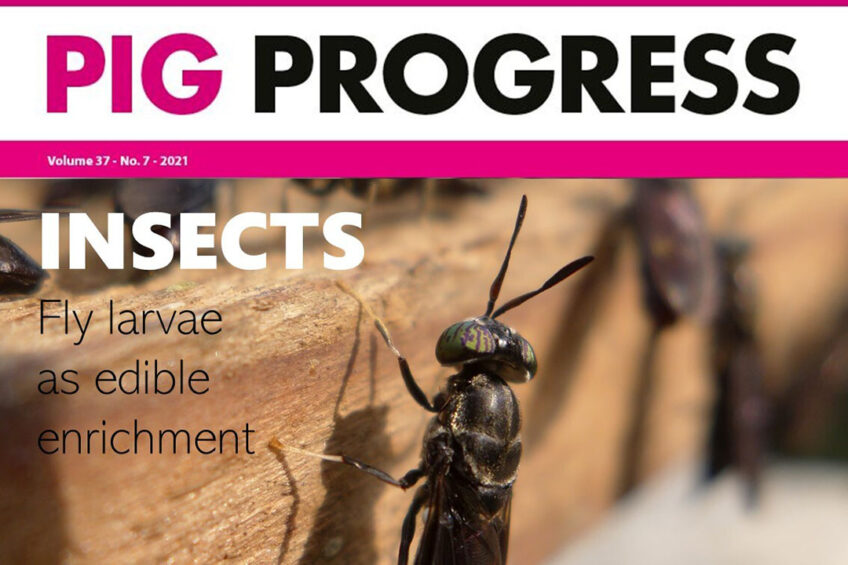Flies, flavours and foraging pigs in Pig Progress 7

The 7th edition of Pig Progress for 2021 is now available online. This edition highlights the range of behavioural and performance benefits from offering weaning piglets live black soldier fly larvae as both a feed ingredient and as edible enrichment. Also, fertilising the soil while loosening it – are pigs the ultimate tractor?
View Pig Progress digital magazine
Pigs flock to the Spanish sun
Pig farming in Spain has accelerated rapidly in recent years and the country has become a destination of choice within the EU for several companies. A combination of factors has contributed to this successful growth, as reported by Kees van Dooren on pages 6-8.

Treating E. coli in the era of prudent use
Regulations, consumer demand and the need to prevent resistance are limiting the use of antibiotics as a treatment for livestock. This article by Huvepharma’s Ulrich Klein, on pages 10-11 focuses on the importance of better understanding the mode of action in various antimicrobial products to prevent overuse.

China taking steps to reduce antibiotics usage
Over the last decade, the Chinese agricultural sector has made tremendous strides in biosecurity and feed formulation to enhance animal health. In doing so, it has also drastically reduced its reliance on the use of antibiotics in veterinary medicine. Read the details in this article by Rebecca Kwakman on pages 12-13.

PCV3 – is it a virus to worry about?
This article on pages 15-17, explores recent research by CReSA-IRTA in Spain into Porcine Circovirus 3 (PCV3). Although the virus may not be as potent as PCV2, there is still cause for concern. Pig Progress’ editor Vincent ter Beek investigates.

High-rise piggeries at Alltech ONE
The annual Alltech One Ideas conference is a platform for industry thought-leaders to come together and share perspectives on a range of topics. On pages 18-19, correspondent Chris McCullough explores new developments in pig housing and technology, driven by the increased demand for pork products worldwide.

Column: Reducing ileitis in summer
In this column on page 20, Dr Francesc Molist, who holds a PhD in animal nutrition, discusses several feeding strategies that can be used in an effort to limit outbreaks of the highly prevalent ileitis bacteria, particularly in summer months.
“Pigs are like the ultimate tractor”
Angus McIntosh is practising regenerative agriculture on Spier Wine Farm in South Africa. His pasture-based farming system advocates for the benefits of using foraging pigs to regenerate the soil back into production on marginal land, as detailed by Chris McCullough on pages 24-26.

Black soldier fly larvae as edible enrichment
A recent exploratory study investigated whether introducing small amounts of live black soldier fly larvae to weaning piglets could ease their transition process to solid feed and improve their overall welfare and performance. A review of the key findings and results Dr Allyson Ipema are on pages 28-29.

Flavours: A versatile, cost-effective solution
From masking off-putting smells to assisting with the successful substitution of more cost-effective feed inputs, the article by Pancosma’s Joëlle Faugeron, Clémentine Oguey and Mario Roman on pages 30-31 explores the many benefits that can be gained from adding flavours to feed, as determined by recent trials in China.

Is iron the missing link for robust weaners?
Although iron is an essential nutritional element in the diets of newly weaned piglets, too much iron can result in several adverse health issues during this important developmental phase. On pages 32-33, Zinpro’s Dr Christof Rapp looks at ways of achieving just the right balance for optimal results.

EU lifts ban on animal by-products in pig feed
This article on pages 34-35 by correspondent Melanie Epp examines the proposed change in EU legislation which allows processed animal protein from pigs to be used in poultry feed and from poultry to be used in pig feed – a move welcomed by farm interest groups.

Reducing ammonia emissions with nutrition
Currently, animal farming accounts for almost 15% of human-derived carbon emissions and in the context of pig production, ammonia is a leading contributor. Nutrition can help tackle this challenge whilst improving profitability for producers. Read the article by DSM’s Carlos Saviani on pages 36-37 to learn more.

Welfare: Enabler of animal performance
There are numerous and complex factors to consider when assessing the welfare and performance of piglets. This article by Rosalie van Emous, Cargill, on page 38 examines how the use of a risk assessment tool and specific nutrition can reduce stress levels in young piglets.

Column: Boar stud welfare
In this column on page 42, Dr Monique Pairis-Garcia discusses the importance of boar welfare and touches on 3 critical factors most relevant to boars, namely housing, social behaviour and euthanasia.











